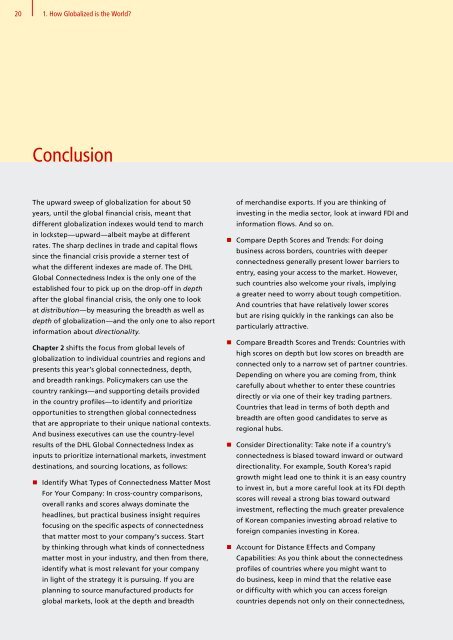DHL Global Connectedness Index 2014
DHL Global Connectedness Index 2014
DHL Global Connectedness Index 2014
- No tags were found...
Create successful ePaper yourself
Turn your PDF publications into a flip-book with our unique Google optimized e-Paper software.
20 1. How <strong>Global</strong>ized is the World<br />
Conclusion<br />
The upward sweep of globalization for about 50<br />
years, until the global financial crisis, meant that<br />
different globalization indexes would tend to march<br />
in lockstep—upward—albeit maybe at different<br />
rates. The sharp declines in trade and capital flows<br />
since the financial crisis provide a sterner test of<br />
what the different indexes are made of. The <strong>DHL</strong><br />
<strong>Global</strong> <strong>Connectedness</strong> <strong>Index</strong> is the only one of the<br />
established four to pick up on the drop-off in depth<br />
after the global financial crisis, the only one to look<br />
at distribution—by measuring the breadth as well as<br />
depth of globalization—and the only one to also report<br />
information about directionality.<br />
Chapter 2 shifts the focus from global levels of<br />
globalization to individual countries and regions and<br />
presents this year’s global connectedness, depth,<br />
and breadth rankings. Policymakers can use the<br />
country rankings—and supporting details provided<br />
in the country profiles—to identify and prioritize<br />
opportunities to strengthen global connectedness<br />
that are appropriate to their unique national contexts.<br />
And business executives can use the country-level<br />
results of the <strong>DHL</strong> <strong>Global</strong> <strong>Connectedness</strong> <strong>Index</strong> as<br />
inputs to prioritize international markets, investment<br />
destinations, and sourcing locations, as follows:<br />
• Identify What Types of <strong>Connectedness</strong> Matter Most<br />
For Your Company: In cross-country comparisons,<br />
overall ranks and scores always dominate the<br />
headlines, but practical business insight requires<br />
focusing on the specific aspects of connectedness<br />
that matter most to your company’s success. Start<br />
by thinking through what kinds of connectedness<br />
matter most in your industry, and then from there,<br />
identify what is most relevant for your company<br />
in light of the strategy it is pursuing. If you are<br />
planning to source manufactured products for<br />
global markets, look at the depth and breadth<br />
of merchandise exports. If you are thinking of<br />
investing in the media sector, look at inward FDI and<br />
information flows. And so on.<br />
• Compare Depth Scores and Trends: For doing<br />
business across borders, countries with deeper<br />
connectedness generally present lower barriers to<br />
entry, easing your access to the market. However,<br />
such countries also welcome your rivals, implying<br />
a greater need to worry about tough competition.<br />
And countries that have relatively lower scores<br />
but are rising quickly in the rankings can also be<br />
particularly attractive.<br />
• Compare Breadth Scores and Trends: Countries with<br />
high scores on depth but low scores on breadth are<br />
connected only to a narrow set of partner countries.<br />
Depending on where you are coming from, think<br />
carefully about whether to enter these countries<br />
directly or via one of their key trading partners.<br />
Countries that lead in terms of both depth and<br />
breadth are often good candidates to serve as<br />
regional hubs.<br />
• Consider Directionality: Take note if a country’s<br />
connectedness is biased toward inward or outward<br />
directionality. For example, South Korea’s rapid<br />
growth might lead one to think it is an easy country<br />
to invest in, but a more careful look at its FDI depth<br />
scores will reveal a strong bias toward outward<br />
investment, reflecting the much greater prevalence<br />
of Korean companies investing abroad relative to<br />
foreign companies investing in Korea.<br />
• Account for Distance Effects and Company<br />
Capabilities: As you think about the connectedness<br />
profiles of countries where you might want to<br />
do business, keep in mind that the relative ease<br />
or difficulty with which you can access foreign<br />
countries depends not only on their connectedness,





